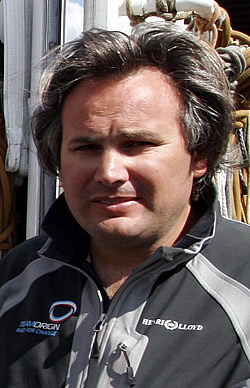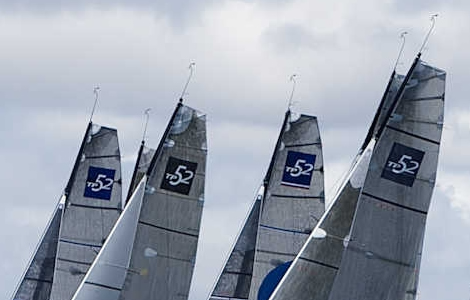
2010 TP52 rule teething problems
With a new set of rules for this year, including the abandonment of spinnaker poles in favour of A-sails and bowsprits plus single backstays replaced by twin backstays, so the first regatta of the Audi MedCup in Cascais is causing a fair share of headaches for the rules arbitrators.
The areas of controversy that have emerged are the winglets on the keel bulb of TeamOrigin’s brand new TP52, which was designed by Juan Kouyoumdjian, himself no stranger to pushing rules to their limits. But Kouyoumdjian is not alone, for the mainsail on the Judel-Vrolijk designed Matador is also under scrutiny as it is slightly larger than everyone else’s thanks to the team spotting a loophole in the mainsail measurement procedure.
The winglet issue is fairly contentious. The bulb on the TeamOrigin TP52 is longer than on the other boats and is fitted with winglets, similar but smaller, than those found on Cup boats, fitted at the aft end of the bulb. The TP52 rule allows a keel’s bulb to have a maximum width of 800mm, so TeamOrigin argue that as clearly a bulb would never be 0.8m across, it would seem that this rule, by implication, allows winglets of some sort. However this conflicts with a rule that Juan K has more than once found himself up against. Rob Weiland, who manages the TP52 Class and who is also its Chief Measurer explains: “We try to keep a unity in the class and the class rule says you can play with dimensions, but you have to stay within what is written within the class rules and the class rule doesn’t say you can have wings on a bulb.”
So if this is the case, then why did TeamOrigin’s TP52 pass measurement for the Audi MedCup’s first regatta in Cascais? Weiland says he only got to hear of the winglets for the first time a week or so ago. “It is a long story. Let’s put it this way – if I was 100% sure that they had on purpose presented this to me at a very late moment to create pressure on a possible ruling, then I would have had no doubt about banning this before. There are circumstances that indicate that they didn’t do this on purpose, but for some reason the message didn’t get through to me. So I give them the benefit of the doubt.”
As a result TeamOrigin 1851 only has a certificate for this first Audi MedCup event and will then have to take measures to rectify the problem.
 Juan K is obviously incensed. “I think the way they are managing this...” he begins. “I don’t understand why people that deal with rules have to...I don’t know what they want. Now Matador has a problem too - which is ridiculous. Why can’t they apply the rule as it is written and just be happy for people to find good stuff? Why can’t we be in a world like that? Why do you have to be obsessed by ‘he’s got a good idea, so let’s kill it!’ It is such mediocrity. It is ridiculous.”
Juan K is obviously incensed. “I think the way they are managing this...” he begins. “I don’t understand why people that deal with rules have to...I don’t know what they want. Now Matador has a problem too - which is ridiculous. Why can’t they apply the rule as it is written and just be happy for people to find good stuff? Why can’t we be in a world like that? Why do you have to be obsessed by ‘he’s got a good idea, so let’s kill it!’ It is such mediocrity. It is ridiculous.”
Kouyoudmjian maintains that Karl Kwok’s TP52 Beau Geste sailed for a whole season with wings on the bulb at a time when this aspect of the TP52 rule was exactly the same. “The rule says it can be 800mm [across], so it has to be a wing. Plus in the past it has happened...”
“I am sick of it. It is not fair. And right now I am not the only one suffering from it,” he concludes, referring to Matador.
According to Rob Weiland the Matador mainsail controversy has arisen due to the way the ‘aft head point’ of a flat top mainsail is defined in ISAF’s Equipment Rules of Sails, that form the basis of the terms used in most class rules.
“By artificially creating a small square top and then sloping down marginally you can reduce this headboard width dramatically in the formula that calculates the area and substantially gain area over the other boats,” says Weiland. “My position until this morning was that the sail was illegal. I couldn’t get a formal interpretation from ISAF but my contact from ISAF said it is probably going to go this way and you probably have to consider that sail as being legal.” The result, according to Weiland, is that the head on the Matador mainsail is almost 1m longer than they currently allow. “It is an odd shape that we cannot call head width, so it is uncontrolled.”

North Sails’ Simon Fry, who sails on Matador, says that the team noted that if the square top is less than 90cm long then it is considered the leech. So the Matador sail has a 90cm long headboard, the 'leech' then drops off at an angle just 10degrees off the horizontal (although in theory it could be as little as 0.1 degrees) thus sidestepping the rule limits for the maximum size of a flat top. Fry reckons that the gain in size on their mainsail through doing this is just 1.1sqm. Structurally it has a ‘gaff batten’ like other flat top sails, but Fry says the sail twists much better with this unusual shape.
The reason this has come about now is that prior to 2010 the TP52s were limited to using a single backstay and this naturally limited the size of the mainsail flat top. For this season the boats are fitted with twin backstays.
A further matter that is likely to become a problem this regatta is the newly introduced guest program. For this season all the TP52s will sail with a guest on board even during official races. A proportion of these slots are allocated to Audi MedCup guests while the others are filled by the team. Obviously given free reign the teams will try and choose light guests for races in lighter conditions and heavier ones when the breeze is up – an identical problem Offshore Challenges have been facing on their Extreme 40 circuit.
“You could expect something like that to happen,” says a resigned Rob Weiland. “The first thing a sailor does is looking out at how to abuse the rule. This is wide open at the moment because we don’t know how to establish a guest program until we’ve tried.
“The professional teams were very much in favour of this [the guest program] because they need money as well. But straight away to start to fight, it is shooting yourself in the foot. But it is the nature of the professional sailor to question everything. They are competitive people so we should not get upset, but they should behave a little bit. With the mainsail and even with the wings – yes, we could make a lot of fuss about nothing, but this circuit represents for every pro sailor at least 80 days of work, for the sail makers at least 300-400 sails every year and it provides bread and butter for a lot of other people. So you have to push but also if the consequence of all your pushing is all this goes away then you can go home and tell your wife that you won the battle but you didn’t win the war. So I feel there has to be a balance.”










Latest Comments
andyn 12/05/2010 - 16:27
That is quite a ridiculous closing comment by Whelan. This class has styled itself at the top of the professional circuit and so the administration should be up to managing professionals. Not telling them to be quiet or they'll lose their income.Andrew1774 12/05/2010 - 15:34
Sounds like an arms race to me whe you have to cast a new bulb when you could use add ons! The spirit always gets taken to the edge. Sounds to me that a bolt on winglet that enhaces performance (also assisting AC foil developemnt) is a very cheap solution and should be encouraged. Its not as if these boats get grounded on the GP circuit. Andy McLellandJames Boyd 12/05/2010 - 14:39
Alex Haworth writes: From memory the original “culture” of the TP52 rules as developed for the Med Circuit was “express exclusion”. If it wasn’t expressly allowed then it was expressly disallowed. An attempt to limit the arms race. So it comes down whether those wings are part of the bulb or not. If they were cast in the same mould at the same time, you could argue they were “the bulb” (just a bulb with a different shape to the norm bu nonetheless a bulb as defined under the rule). If they are add ons then you could argue they are not “the bulb” – and therefore expressly disallowed from the 800mm ruling.Add a comment - Members log in